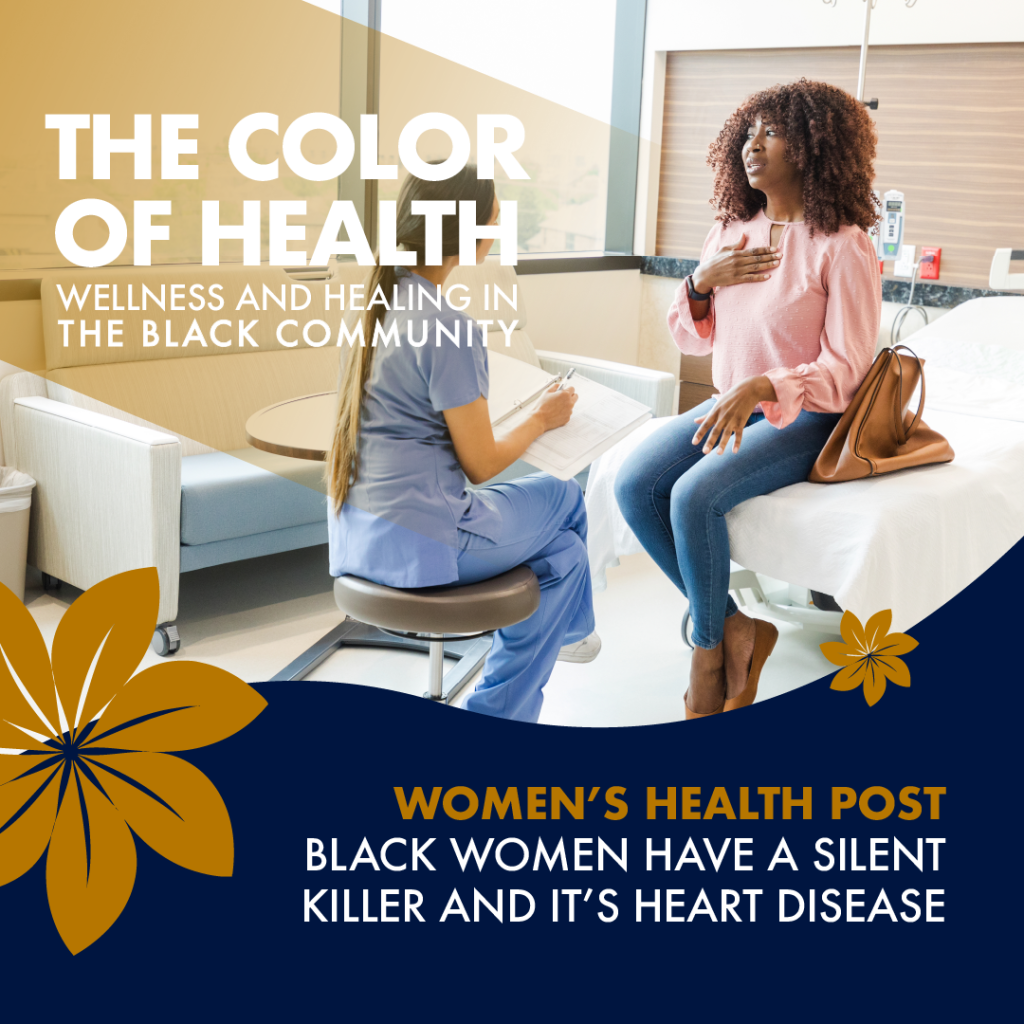Black Women Have A Silent Killer And It's Heart Disease
The Color Of Health: Black Women Have A Silent Killer And It’s Heart Disease

Heart disease is often seen as a condition that primarily affects older men, but the reality tells a very different—and urgent—story for Black women. Despite making up a vital and vibrant part of our communities, Black women are disproportionately affected by heart disease; in fact, it’s the number one cause of death in the community, according to the American Heart Association.
So why are Black women at a higher risk, and what can we do about it?
Higher health risk factors impact Black women.
Heart disease refers to a group of conditions that affect the structure and function of the heart, including coronary artery disease, heart failure, and heart rhythm disorders, according to the Mayo Clinic. These illnesses are serious and can lead to life-threatening complications such as heart attacks and strokes. Black women are more likely than any other group to experience health conditions that significantly raise the risk of developing heart disease. These risk factors are not simply the result of individual choices—they are deeply tied to long-standing social and economic inequities.
Alarmingly, nearly 59% of Black women ages 20 and over are living with some form of cardiovascular disease, including heart disease. Here’s a closer look at the most prevalent risk factors associated with it.
1. High Blood Pressure (Hypertension)
Black women have the highest rates of high blood pressure in the U.S., yet only 25% have it under control. This is one of the strongest predictors of heart disease and cardiac arrest. Chronic high blood pressure can damage the inner walls of blood vessels. As the body tries to repair the damage, cholesterol and fats can build up at the site, forming plaque—a process called atherosclerosis. This narrows the arteries, reduces blood flow, and significantly raises the risk of heart attack and stroke.
Symptoms of heart disease include chest pain, shortness of breath, pain in the neck, jaw, throat, upper belly, or back, as well as numbness or coldness in the legs or arms, Mayo Clinic notes.
2. Obesity
Nearly 57% of Black women are obese, the highest percentage across all racial and gender groups. Excess weight—especially abdominal fat—puts additional strain on the heart and is closely linked to hypertension, diabetes, and high cholesterol.
3. Type 2 Diabetes
Black women are more likely to develop Type 2 diabetes and to go undiagnosed. Diabetes damages blood vessels and nerves that control the heart, making it a major contributor to cardiovascular disease.
4. Stroke
The prevalence of stroke in Black women is twice as high as in white women. Stroke and heart disease are closely linked, often stemming from shared risk factors like high blood pressure and atherosclerosis.
5. High Cholesterol
Elevated levels of “bad” LDL cholesterol and low levels of “good” HDL cholesterol are common and often go untreated. Over time, high cholesterol contributes to the development of plaque in the arteries.
6. Physical Inactivity
Black women are more likely to experience barriers to regular physical activity, such as a lack of safe places to exercise, limited time due to work and caregiving responsibilities, and under-resourced neighborhoods, where food insecurity is prevalent. These barriers make it harder to maintain heart health and prevent weight gain or manage chronic conditions.
Systemic racism and socioeconomic factors are at play.
Black women face a unique intersection of systemic racism and gender bias within the healthcare system. They are less likely to be listened to, believed, or appropriately treated when they report symptoms. Many studies show that Black patients are less likely to receive timely interventions for heart-related symptoms or preventative care.
Access to high-quality healthcare and insurance remains a significant barrier. Notably, a 2024 study by KFF highlighted that as coverage gains began to reverse in 2017, the dramatic effect caused three consecutive years of increased uninsured rates. As of 2022, nonelderly American Indian and Alaska Native (AIAN) individuals (19%) and Hispanic individuals (18%) had the highest uninsured rates. Uninsured rates among nonelderly Native Hawaiian and Pacific Islander (NHPI) individuals (13%) and Black individuals (10%) also exceeded those of their White counterparts (7%).
Without insurance, early diagnosis and effective treatment options can not be distributed, which leaves many Black women undiagnosed or untreated until it’s too late. The constant stress of navigating racism, sexism, and socioeconomic barriers—often referred to as “weathering” according to NCRC—has a physiological impact on the body. Chronic stress raises cortisol levels, increases blood pressure, and contributes to inflammation in the arteries, all of which are major risk factors for heart disease.

What can be done?
Addressing the heart disease crisis among Black women requires a multifaceted approach. First and foremost, healthcare providers must receive training in culturally competent care. This means recognizing their own biases and delivering services that are respectful of and responsive to the unique needs of Black women. Building trust through culturally sensitive practices is essential to improving health outcomes.
At the same time, community empowerment plays a crucial role. Faith-based organizations, sororities, and grassroots groups are well-positioned to spread awareness, foster meaningful dialogue, and offer emotional and practical support within trusted spaces. Policy change is another vital piece of the puzzle. Expanding access to affordable healthcare, investing in community wellness programs, and tackling the social determinants of health—such as housing, education, and employment—are all necessary steps toward achieving health equity.
While systemic change is essential, self-advocacy remains an important tool. Black women should feel empowered to ask questions, seek second opinions, and advocate for better care. However, the burden of navigating inequitable systems should not fall on individuals alone; institutions must also be held accountable. Heart disease remains the number one health threat to Black women, yet many are unaware of this fact. Public health campaigns often fail to reflect the lived experiences of Black women or communicate in ways that resonate with their realities. Without culturally relevant education and outreach, awareness and prevention efforts continue to fall short.
Fortunately, there are concrete steps that can significantly lower the risk of heart disease. According to the Sarver Heart Center, staying physically active through a mix of cardiovascular exercise, strength training, flexibility, balance, and coordination is essential. Monitoring key health numbers is also critical. Black women should regularly check their cholesterol levels (total, LDL, HDL), triglycerides, fasting glucose, HbA1c, blood pressure (which should ideally be 130/80 or lower), BMI (with a target range of 20–25), and other relevant indicators like insulin, Vitamin D, and coronary calcium score where appropriate.
Nutrition plays a foundational role as well. Embracing a whole-food, plant-based diet—rich in greens, beans, vibrant fruits and vegetables, whole grains, nuts, and seeds—can dramatically reduce risk. Moving away from the Standard American Diet (SAD) and exploring different diets, the Mediterranean Diet or the MIND diet, can help support this dietary shift. Together, these strategies offer a path toward better heart health and greater overall well-being for Black women.
Remember, your heart matters. Your life matters. Let’s fight for both.
SEE MORE:





